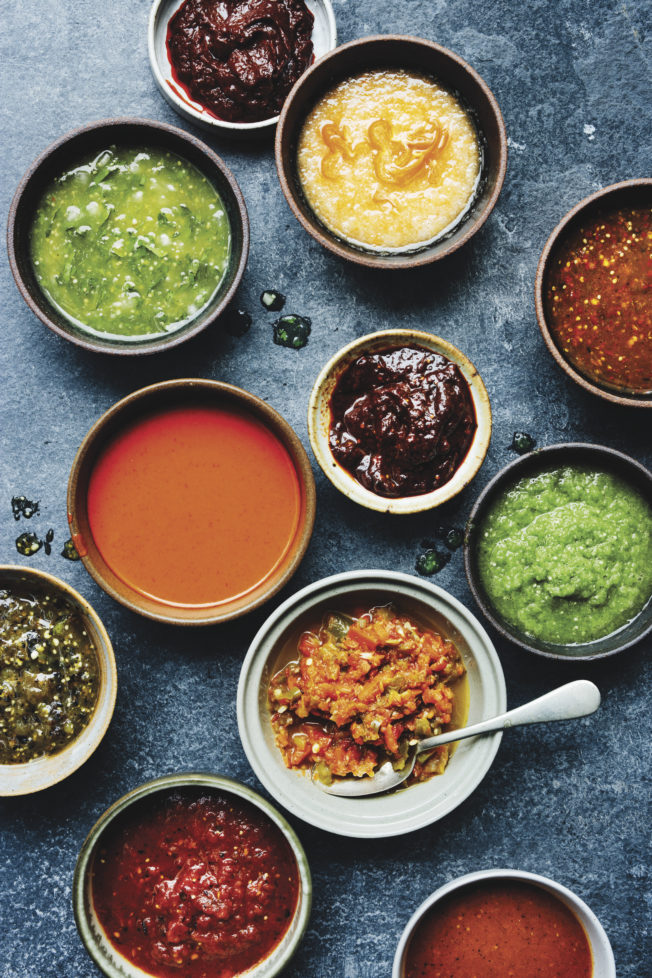
An array of salsas from the Nopalito cookbook. Photo credit: Eva Kolenko
In a couple days, restaurants across the country will be stockpiling kitchens with margarita mix, chips and salsa in preparation for revelers who are capitalizing on Cinco de Mayo as an excuse to eat Mexican food. But if you really want to commemorate the holiday, which marks Mexico’s unlikely victory in a nineteenth-century battle against France, a different way to do so might involve celebrating regional Mexican food in all its variety and freshness.
Nopalito: A Mexican Kitchen aims to do just that. In the new cookbook, inspired by the beloved San Francisco restaurant of the same name, authors Gonzalo Guzmán and Stacy Adimando hope to shed the cuisine of its many stereotypes and Western bastardizations. Flip through the book, and you’ll see dishes like birria, machaca and enmoladas alongside alongside tacos and guacamole.
Turns out dipping chips with salsa is more of an American thing than a Mexican thing.
Arguably the most eye-opening part of the book is the entire chapter dedicated to salsas, where Guzmán, the restaurant’s chef, explains how various types of salsas are used in Mexico: less as a dip for chips, more as a spice, a marinade and topping for tacos. “Salsas are part of a Mexican chef’s tradition and can even tell the story of a cook’s childhood, like where they might have grown up in Mexico, for example,” he tells us, adding, “Since salsa have so many uses in Mexican cooking, they are the building blocks of so many dishes.”
This means they go far beyond the function of chip flavoring agent at happy hour. “Dipping chips in salsa is more of an American thing,” he explains. Instead, in Mexico, red or green salsas might be tossed with day-old tortillas to make chilaquiles for breakfast, mixed into cooked shrimp, and used as a filling for empanadas, or utilized as a base for braises: “In our Birria al Res (a short rib stew), we make a salsa with diced tomatoes, garlic, and cascabel chiles, blend it with an adobo, and use that as a flavor base for stewing the ribs.”
Beyond their use, Mexican salsas can defy all flavor stereotypes, too. Some of them, like Guzmán’s salsa macha, forgo the tomatoes and onions in favor of oil, nuts and vinegar.
“Salsa macha has a nuttiness and richness, like spicy peanut butter.”—Gonzalo Guzmán
“Salsa macha is traditionally made with ground peanuts, which give it a creamy nuttiness and richness, almost like a spicy peanut butter,” Guzmán says. “In our version at Nopalito, we use raw sunflower seeds. It’s got a great slightly grainy texture, meaning it clings well to foods.” He uses the sauce to add heat to antojitos, the category of casual Mexican foods that include things like garnachas, empanadas, and corn quesadillas.
“Tasting a special salsa,” the chef adds, “can enliven an entire meal.” With the recipe below, try this unique and uncommon salsa for yourself.
Salsa Macha
Makes about 3/4 cup
This is a very special salsa—complex, nutty, and rich, yet vinegary, with a nice moderate-to-strong level of heat. We use sunflower seeds in our recipe, but salsa macha is traditionally made with coarsely ground peanuts. You can really taste the dried oregano, which gives it an herbaceous quality, and the sunflower seeds, which give it a bit of body and even a slightly grainy texture, making this a great option for dunking chips or quesadillas into.
Keep a close eye on the chiles while they are roasting. They can burn quickly, which will give the salsa a bitter taste and dark color.
1/4 cup raw unsalted sunflower seeds
12 medium dried chiles de árbol, stemmed and seeded
1 dried ancho chile, stemmed and seeded
2 tablespoons white vinegar
2 medium cloves garlic
1 1/2 teaspoons dried oregano
1/4 cup olive oil
Salt
Preheat the oven to 350ºF. Add the sunflower seeds and chiles to a small baking sheet. Roast for 2 minutes, then remove the chiles (leave the sunflower seeds on the pan); continue to roast the seeds until lightly toasted, about 5 minutes more.
Transfer the chiles to a medium heatproof bowl and add boiling water to cover; let soak until softened, about 20 minutes.
Transfer the chiles (reserve the soaking water) to a blender; puree until a thick paste forms, adding a little of the soaking water only as needed to help blend. Add the toasted sunflower seeds, vinegar, garlic, and oregano; with the motor running, slowly drizzle the oil until the salsa is emulsified but still lightly chunky. Taste and adjust the seasoning as necessary.
Reprinted with permission from Nopalito by Gonzalo Guzmán with Stacy Adimando, copyright © 2017. Photography by Eva Kolenko. Published by Ten Speed Press, an imprint of Penguin Random House.

1 comment
love your catalogs since I do not live near a store.